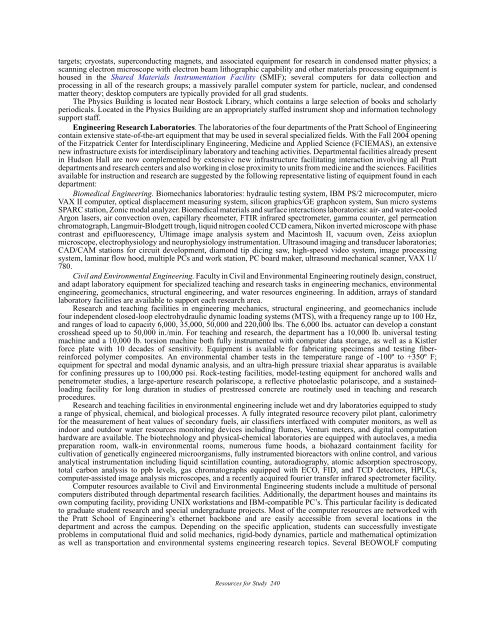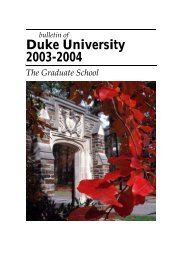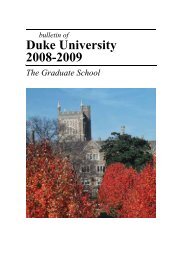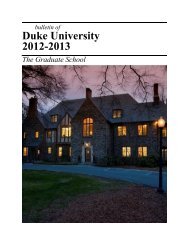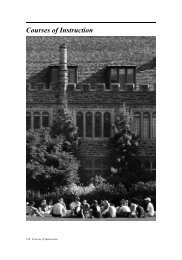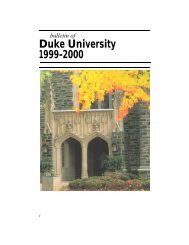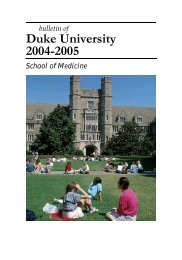Duke University 2009-2010 - Office of the Registrar - Duke University
Duke University 2009-2010 - Office of the Registrar - Duke University
Duke University 2009-2010 - Office of the Registrar - Duke University
Create successful ePaper yourself
Turn your PDF publications into a flip-book with our unique Google optimized e-Paper software.
targets; cryostats, superconducting magnets, and associated equipment for research in condensed matter physics; a<br />
scanning electron microscope with electron beam lithographic capability and o<strong>the</strong>r materials processing equipment is<br />
housed in <strong>the</strong> Shared Materials Instrumentation Facility (SMIF); several computers for data collection and<br />
processing in all <strong>of</strong> <strong>the</strong> research groups; a massively parallel computer system for particle, nuclear, and condensed<br />
matter <strong>the</strong>ory; desktop computers are typically provided for all grad students.<br />
The Physics Building is located near Bostock Library, which contains a large selection <strong>of</strong> books and scholarly<br />
periodicals. Located in <strong>the</strong> Physics Building are an appropriately staffed instrument shop and information technology<br />
support staff.<br />
Engineering Research Laboratories. The laboratories <strong>of</strong> <strong>the</strong> four departments <strong>of</strong> <strong>the</strong> Pratt School <strong>of</strong> Engineering<br />
contain extensive state-<strong>of</strong>-<strong>the</strong>-art equipment that may be used in several specialized fields. With <strong>the</strong> Fall 2004 opening<br />
<strong>of</strong> <strong>the</strong> Fitzpatrick Center for Interdisciplinary Engineering, Medicine and Applied Science (FCIEMAS), an extensive<br />
new infrastructure exists for interdisciplinary laboratory and teaching activities. Departmental facilities already present<br />
in Hudson Hall are now complemented by extensive new infrastructure facilitating interaction involving all Pratt<br />
departments and research centers and also working in close proximity to units from medicine and <strong>the</strong> sciences. Facilities<br />
available for instruction and research are suggested by <strong>the</strong> following representative listing <strong>of</strong> equipment found in each<br />
department:<br />
Biomedical Engineering. Biomechanics laboratories: hydraulic testing system, IBM PS/2 microcomputer, micro<br />
VAX II computer, optical displacement measuring system, silicon graphics/GE graphcon system, Sun micro systems<br />
SPARC station, Zonic modal analyzer. Biomedical materials and surface interactions laboratories: air- and water-cooled<br />
Argon lasers, air convection oven, capillary rheometer, FTIR infrared spectrometer, gamma counter, gel permeation<br />
chromatograph, Langmuir-Blodgett trough, liquid nitrogen cooled CCD camera, Nikon inverted microscope with phase<br />
contrast and epifluorescency, Ultimage image analysis system and Macintosh II, vacuum oven, Zeiss axioplun<br />
microscope, electrophysiology and neurophysiology instrumentation. Ultrasound imaging and transducer laboratories;<br />
CAD/CAM stations for circuit development, diamond tip dicing saw, high-speed video system, image processing<br />
system, laminar flow hood, multiple PCs and work station, PC board maker, ultrasound mechanical scanner, VAX 11/<br />
780.<br />
Civil and Environmental Engineering. Faculty in Civil and Environmental Engineering routinely design, construct,<br />
and adapt laboratory equipment for specialized teaching and research tasks in engineering mechanics, environmental<br />
engineering, geomechanics, structural engineering, and water resources engineering. In addition, arrays <strong>of</strong> standard<br />
laboratory facilities are available to support each research area.<br />
Research and teaching facilities in engineering mechanics, structural engineering, and geomechanics include<br />
four independent closed-loop electrohydraulic dynamic loading systems (MTS), with a frequency range up to 100 Hz,<br />
and ranges <strong>of</strong> load to capacity 6,000, 35,000, 50,000 and 220,000 lbs. The 6,000 lbs. actuator can develop a constant<br />
crosshead speed up to 50,000 in./min. For teaching and research, <strong>the</strong> department has a 10,000 lb. universal testing<br />
machine and a 10,000 lb. torsion machine both fully instrumented with computer data storage, as well as a Kistler<br />
force plate with 10 decades <strong>of</strong> sensitivity. Equipment is available for fabricating specimens and testing fiberreinforced<br />
polymer composites. An environmental chamber tests in <strong>the</strong> temperature range <strong>of</strong> -100º to +350º F;<br />
equipment for spectral and modal dynamic analysis, and an ultra-high pressure triaxial shear apparatus is available<br />
for confining pressures up to 100,000 psi. Rock-testing facilities, model-testing equipment for anchored walls and<br />
penetrometer studies, a large-aperture research polariscope, a reflective photoelastic polariscope, and a sustainedloading<br />
facility for long duration in studies <strong>of</strong> prestressed concrete are routinely used in teaching and research<br />
procedures.<br />
Research and teaching facilities in environmental engineering include wet and dry laboratories equipped to study<br />
a range <strong>of</strong> physical, chemical, and biological processes. A fully integrated resource recovery pilot plant, calorimetry<br />
for <strong>the</strong> measurement <strong>of</strong> heat values <strong>of</strong> secondary fuels, air classifiers interfaced with computer monitors, as well as<br />
indoor and outdoor water resources monitoring devices including flumes, Venturi meters, and digital computation<br />
hardware are available. The biotechnology and physical-chemical laboratories are equipped with autoclaves, a media<br />
preparation room, walk-in environmental rooms, numerous fume hoods, a biohazard containment facility for<br />
cultivation <strong>of</strong> genetically engineered microorganisms, fully instrumented bioreactors with online control, and various<br />
analytical instrumentation including liquid scintillation counting, autoradiography, atomic adsorption spectroscopy,<br />
total carbon analysis to ppb levels, gas chromatographs equipped with ECO, FID, and TCD detectors, HPLCs,<br />
computer-assisted image analysis microscopes, and a recently acquired fourier transfer infrared spectrometer facility.<br />
Computer resources available to Civil and Environmental Engineering students include a multitude <strong>of</strong> personal<br />
computers distributed through departmental research facilities. Additionally, <strong>the</strong> department houses and maintains its<br />
own computing facility, providing UNIX workstations and IBM-compatible PC’s. This particular facility is dedicated<br />
to graduate student research and special undergraduate projects. Most <strong>of</strong> <strong>the</strong> computer resources are networked with<br />
<strong>the</strong> Pratt School <strong>of</strong> Engineering’s e<strong>the</strong>rnet backbone and are easily accessible from several locations in <strong>the</strong><br />
department and across <strong>the</strong> campus. Depending on <strong>the</strong> specific application, students can successfully investigate<br />
problems in computational fluid and solid mechanics, rigid-body dynamics, particle and ma<strong>the</strong>matical optimization<br />
as well as transportation and environmental systems engineering research topics. Several BEOWOLF computing<br />
Resources for Study 240


